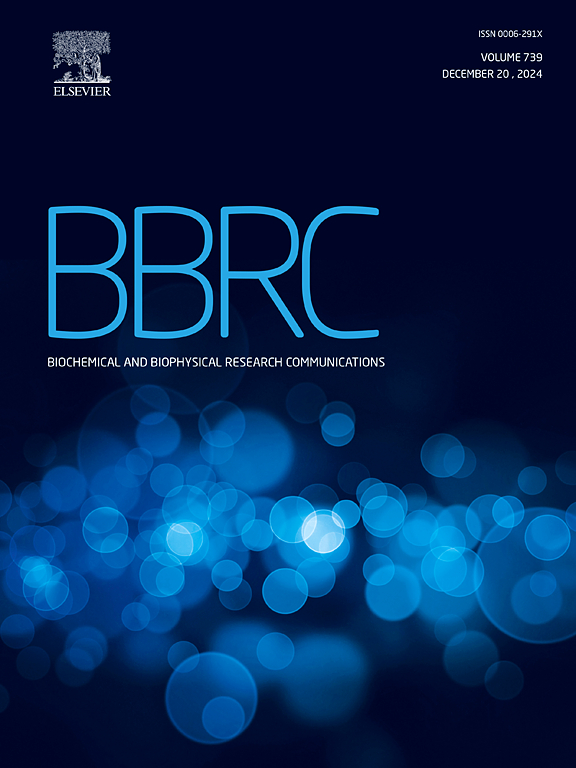RWP-RK及其靶点的相互作用:丝氨酸的作用及其在物种间的保护
IF 2.5
3区 生物学
Q3 BIOCHEMISTRY & MOLECULAR BIOLOGY
Biochemical and biophysical research communications
Pub Date : 2025-04-04
DOI:10.1016/j.bbrc.2025.151750
引用次数: 0
摘要
RWP-RK结构域是存在于所有NIN(结节起始)/NLP (NIN样蛋白)和RKD (RWP-RK结构域)转录因子(TFs)中的关键dna结合结构域。NINs/ nlp中的RWP-RK结构域包含一个高度进化保守的序列RWPSRK,而在rkd中,第四个丝氨酸(S)氨基酸被酪氨酸(Y)或组氨酸(H)取代。为了调节结瘤的自动调节,NIN TF的RWP-RK结构域与CLE肽的启动子区域结合,而不是与rkd结合。因此,从结构角度研究蛋白质- dna相互作用对于理解RWP-RK结构域丝氨酸(S)残基的进化意义至关重要。在此,我们模拟了野生型(WT)和变体RWP-RK结构域,其中包含谷氨酸(E)、酪氨酸(Y)和组氨酸(H)等取代,并将它们与模拟的pCLE13顺式元件对接。我们的对接结果显示,RWP-RK结构域的一个螺旋-转-螺旋(HTH)基序与pCLE13相互作用。WT HTH-DNA配合物显示出最大的负结合自由能,表明它们之间的相互作用很强,特别是氢键作用。WT和变异模型的模拟分析为蛋白质- dna结合动力学提供了更深入的见解。氢键占用率表明,第四个丝氨酸(S)残基对于维持与DNA的显著比例的氢键至关重要。取代这个保守丝氨酸(S)残基的变异在与DNA结合时表现出能量挫折,并且在它们的残基之间失去了相关性。总的来说,这表明所有NINs/ nlp的RWP-RK结构域的丝氨酸(S)残基对于适当的蛋白质- dna相互作用至关重要,这可能是它们生物学相关性所必需的。本文章由计算机程序翻译,如有差异,请以英文原文为准。
Insights into the interactions of RWP-RK and their targets: Role of serine and its conservation across species
The RWP-RK domain is a key DNA-binding domain found in all NIN (Nodule Inception)/NLP (NIN-like proteins) and RKD (RWP-RK Domain Containing) transcription factors (TFs). The RWP-RK domain in NINs/NLPs contains a highly evolutionarily conserved sequence, RWPSRK, while in RKDs, the fourth serine (S) amino acid is substituted with either tyrosine (Y) or histidine (H). To regulate autoregulation of nodulation, the RWP-RK domain of NIN TF binds to the promoter region of CLE peptides but not RKDs. Therefore, investigating the protein-DNA interaction from a structural perspective is essential to understand the evolutionary significance of the serine (S) residue of the RWP-RK domain. Herein, we have modelled both the wild type (WT) and the variant RWP-RK domains containing substitutions like glutamic acid (E), tyrosine (Y), and histidine (H) and docked them with the modelled pCLE13 cis-element. Our docking results revealed that a helix-turn-helix (HTH) motif of the RWP-RK domain interacts with pCLE13. The WT HTH-DNA complex exhibited the most negative binding free energy, indicating a strong interaction, particularly hydrogen bonds acting between them. Simulation analysis of WT and variant models provided deeper insights into protein-DNA binding dynamics. The hydrogen bond occupancy percentage indicated that the fourth serine (S) residue is vital for maintaining a significant percentage of hydrogen bonds with DNA. The variants substituting this conserved serine (S) residue displayed energetic frustration upon binding to DNA and lost correlation among their residues. Overall, it suggested that serine (S) residue of the RWP-RK domain of all NINs/NLPs is crucial for appropriate protein-DNA interaction, which might be required for their biological relevance.
求助全文
通过发布文献求助,成功后即可免费获取论文全文。
去求助
来源期刊
CiteScore
6.10
自引率
0.00%
发文量
1400
审稿时长
14 days
期刊介绍:
Biochemical and Biophysical Research Communications is the premier international journal devoted to the very rapid dissemination of timely and significant experimental results in diverse fields of biological research. The development of the "Breakthroughs and Views" section brings the minireview format to the journal, and issues often contain collections of special interest manuscripts. BBRC is published weekly (52 issues/year).Research Areas now include: Biochemistry; biophysics; cell biology; developmental biology; immunology
; molecular biology; neurobiology; plant biology and proteomics

 求助内容:
求助内容: 应助结果提醒方式:
应助结果提醒方式:


